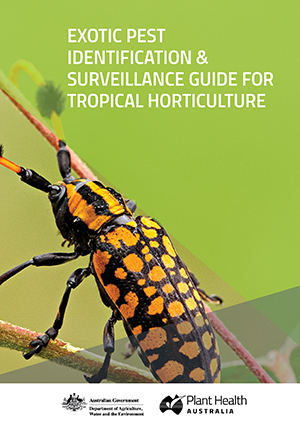Read the latest information on
Foot-and-mouth disease
 Plant Health Australia’s latest resource for growers is the Exotic Pest Identification and Surveillance Guide for Tropical Horticulture, developed with funding from the Australia Government Department of Agriculture and Water Resources.
Plant Health Australia’s latest resource for growers is the Exotic Pest Identification and Surveillance Guide for Tropical Horticulture, developed with funding from the Australia Government Department of Agriculture and Water Resources.
Inspecting crops for signs of new pests is one way you can protect Australia’s plant industries from exotic pests, as early detection and reporting improves the chances of successfully containing or eradicating new pests.
The guide is in two sections:
Biosecurity and surveillance – which describes key aspects of on-farm biosecurity, how to undertake pest surveillance in the field and packing sheds, handling pest samples and reporting unusual finds.
Identification of key exotic pests – which provides information on the high priority exotic pests for several of the horticultural crops grown in northern Australia. The guide has been developed to increase your awareness of these pests and provide you with information on what to do if you suspect you have found one.
The surveillance section describes how to survey for pests and diseases in growing blocks, and how to assess fruit in packing sheds. Advice is also provided on trapping surveys, like where to place traps, trap inspection, and how to find the coordinates of your geographical position using a mobile phone.
In case you do find something unusual, there’s information about what to do with samples of insect pests and diseased plant material, and how to report what you’ve found.
The pest identification pages provide images of the pest or disease symptoms, under the following headings:
The guide mostly contains information on the high priority pests of a range of crops grown in northern Australia. While there are many more exotic pests, most of the pests in this guide have been categorised as high priority pests by industry, based on a number of factors, including:
Once the probabilities of entry, establishment and spread have been estimated for the pest, and an assessment of the likely economic consequences has been made, this information is combined to achieve an overall risk rating. This guide highlights pests that have an extreme or high risk rating.
Crops specifically covered are avocados, bananas, citrus, lychees, mangoes, melons, papaya, passionfruit, pineapples and tropical vegetables. Exotic fruit flies get a special mention, as pests of multiple tropical crops
You can also download a pdf copy from the Surveillance section of the Plant Health Australia website